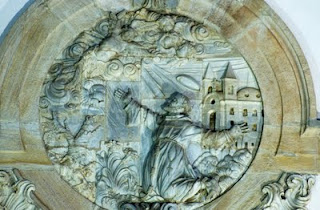
 Aleijadinho (b. Antônio Francisco Lisboa; 1730 or 1738 – November 18, 1814) was a Colonial Brazil-born sculptor and architect, noted for his works on and in various churches of Brazil. His crowning achievement was the Twelve Prophets at the Sanctuary of Bom Jesus of Matosinhos at Congonhas.
Aleijadinho (b. Antônio Francisco Lisboa; 1730 or 1738 – November 18, 1814) was a Colonial Brazil-born sculptor and architect, noted for his works on and in various churches of Brazil. His crowning achievement was the Twelve Prophets at the Sanctuary of Bom Jesus of Matosinhos at Congonhas.

 Born in Vila Rica (Rich Town), whose name was later changed to Ouro Preto (Black Gold), Minas Gerais, Brazil, in 1738 (sometimes said to be in 1730) he was the son of Manuel Francisco da Costa Lisboa, a Portuguese man and his African slave, Isabel. His father, a carpenter, had immigrated to Brazil where his skills were so in demand that he appears to have been elevated to the position of architect.
Born in Vila Rica (Rich Town), whose name was later changed to Ouro Preto (Black Gold), Minas Gerais, Brazil, in 1738 (sometimes said to be in 1730) he was the son of Manuel Francisco da Costa Lisboa, a Portuguese man and his African slave, Isabel. His father, a carpenter, had immigrated to Brazil where his skills were so in demand that he appears to have been elevated to the position of architect.Within a very short time he had become a noted architect himself and had designed and constructed the Chapel of the Third Order of St. Francis of Assisi in Ouro Preto. He had also executed the carvings on the building, the most notable being a round bas-relief depicting St. Francis receiving the stigmata.
It was shortly thereafter that the signs of a debilitating disease, probably leprosy, began to show and not long after that Antonio received the name by which he has come down through history, "o Aleijadinho", "The Little Cripple." Aleijadinho was disfigured and crippled by leprosy, and created his masterpiece with his chisel and hammer, tied to his fingerless hands. Between 1800 and 1805 Aleijadinho sculpted the twelve soapstone figures by having his assistants strap his hammer and chisels to what remained of his hands, which did not at this point include fingers. Since he no longer had feet to stand on he had pads strapped to his knees up which he'd climb the ladders needed to get him off the ground. The Twelve Prophets are arranged around the courtyard and stairway in front of the church.
Source: Wikipedia




No comments:
Post a Comment